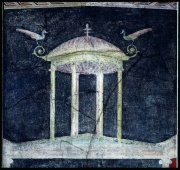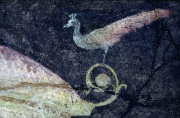Difference between revisions of "Fresco pigments"
Jump to navigation
Jump to search
(username removed) |
|||
| (7 intermediate revisions by 4 users not shown) | |||
| Line 1: | Line 1: | ||
| − | [[File:25.44-P-48-1.jpg|thumb|]] | + | [[File:25.44-P-48-1.jpg|thumb|Fresco Panel<br>MFA# 25.44]] |
== Description == | == Description == | ||
| − | A group of pigments that remain stable and chemically resistant to the lime plaster used as a base in fresco paintings. The highly alkaline, lime base in fresco paintings may react with and alter the color of some pigments. For example, [ | + | A group of pigments that remain stable and chemically resistant to the lime plaster used as a base in fresco paintings. The highly alkaline, lime base in fresco paintings may react with and alter the color of some pigments. For example, [[Prussian blue]] and [[chrome yellow]] both discolor within a few hours. [[Lead white]] may turn black slowly. Other pigments, such as some [[ultramarine blue, natural|ultramarines]] and [[ivory black]], may contain dissolved salts that will slowly leach to the surface and leave a white efflorescence. Examples of fresco pigments are: [[carbon black]], [[hematite|iron oxide]], and [[cobalt blue]]. |
| − | [[File:25.44-P-48-3.jpg|thumb|Detail of fresco | + | [[File:25.44-P-48-3.jpg|thumb|Detail of fresco''(Shown above)'']] |
| + | [[File:21.1285-P-3-2.jpg|thumb|Detail of fresco<br>MFA#21.1285]] | ||
| − | |||
== Synonyms and Related Terms == | == Synonyms and Related Terms == | ||
limeproof pigments; pigmentos para el fresco (Esp.); pigmentos resistentes a la cal (Esp.); pigments pour fresque (Fr.); pigmentos para pintura a fresco (Port.) | limeproof pigments; pigmentos para el fresco (Esp.); pigmentos resistentes a la cal (Esp.); pigments pour fresque (Fr.); pigmentos para pintura a fresco (Port.) | ||
| − | == | + | == Resources and Citations == |
| − | + | * Ralph Mayer, ''A Dictionary of Art Terms and Techniques'', Harper and Row Publishers, New York, 1969 (also 1945 printing) | |
| − | + | * Kurt Wehlte, ''The Materials and Techniques of Painting'', Van Nostrand Reinhold Co., New York, 1975 Comment: p. 254 | |
| − | |||
| − | |||
| − | |||
| − | |||
| − | |||
| − | |||
| − | |||
| − | |||
| − | * | ||
| − | |||
| − | |||
[[Category:Materials database]] | [[Category:Materials database]] | ||
Latest revision as of 13:46, 15 August 2020
Description
A group of pigments that remain stable and chemically resistant to the lime plaster used as a base in fresco paintings. The highly alkaline, lime base in fresco paintings may react with and alter the color of some pigments. For example, Prussian blue and Chrome yellow both discolor within a few hours. Lead white may turn black slowly. Other pigments, such as some ultramarines and Ivory black, may contain dissolved salts that will slowly leach to the surface and leave a white efflorescence. Examples of fresco pigments are: Carbon black, iron oxide, and Cobalt blue.
Synonyms and Related Terms
limeproof pigments; pigmentos para el fresco (Esp.); pigmentos resistentes a la cal (Esp.); pigments pour fresque (Fr.); pigmentos para pintura a fresco (Port.)
Resources and Citations
- Ralph Mayer, A Dictionary of Art Terms and Techniques, Harper and Row Publishers, New York, 1969 (also 1945 printing)
- Kurt Wehlte, The Materials and Techniques of Painting, Van Nostrand Reinhold Co., New York, 1975 Comment: p. 254


